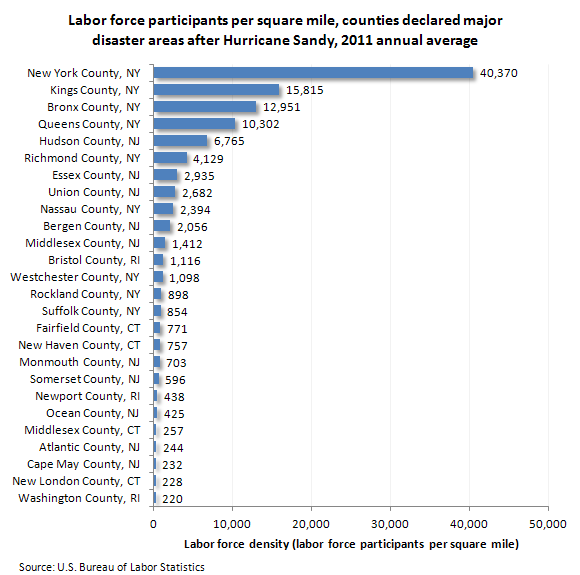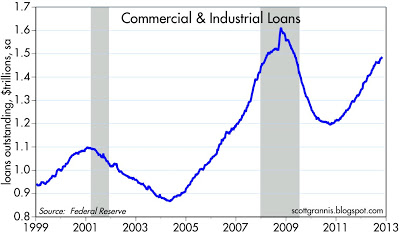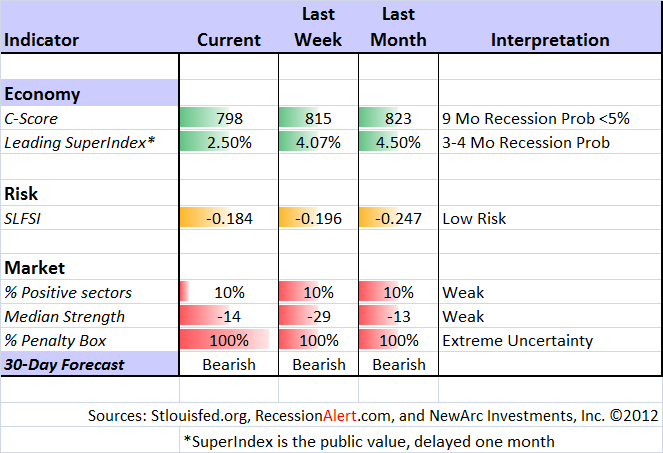This week will provide the usual flow of data, some political posturing, and more than the typical quota of speeches.
Expect more noise than signal!
- Congress resumes the lame-duck session. There will be plenty of talk, followed breathlessly by the pundits.
- Lobbying groups are joining in to influence the fiscal cliff debate.
- The Fed is out of the "quiet period" and participants will be on the speech circuit.
- Data will continue to show the effects of Sandy.
The BLS released an excellent report showing labor force size and density in the areas most affected both by the original storm and later flooding.
"It will be months before the economic impact of Sandy can be fully assessed using data from the U.S. Bureau of Labor Statistics and other organizations. This Spotlight on Statistics provides a brief look at the pre-Sandy labor market in some of the areas of the United States hit hardest by the storm."
I'll offer my own take on how to find this week's signals in the conclusion. Let us first do our regular review of last week's news and data.
Background on "Weighing the Week Ahead"
There are many good lists of upcoming events. One source I especially like is the weekly post from the WSJ's Market Beat blog. There is a nice combination of data, speeches, and other events.
In contrast, I highlight a smaller group of events. My theme is an expert guess about what we will be watching on TV and reading in the mainstream media. It is a focus on what I think is important for my trading and client portfolios.
This is unlike my other articles where I develop a focused, logical argument with supporting data on a single theme. Here I am simply sharing my conclusions. Sometimes these are topics that I have already written about, and others are on my agenda. I am putting the news in context.
Readers often disagree with my conclusions. Do not be bashful. Join in and comment about what we should expect in the days ahead. This weekly piece emphasizes my opinions about what is really important and how to put the news in context. I have had great success with my approach, but feel free to disagree. That is what makes a market!
Last Week's Data
Each week I break down events into good and bad. Often there is "ugly" and on rare occasion something really good. My working definition of "good" has two components:
- The news is market-friendly. Our personal policy preferences are not relevant for this test. And especially -- no politics.
- It is better than expectations.
The economic news last week was pretty.
- Cease fire in the Mideast.
- Insider buying suggests a year-end rally. (via Mark Hulbert).
- The Chinese economy shows improvement. See the nice article from Kate Mackenzie.
- Existing home sales were strong (via Steven Hansen). Building permits were in line with expectations -- still pretty good.
- Fewer legislators are bound by "the pledge." While we all want to see a clear path to deficit reduction, it will be achieved more readily through compromise.
- LA port traffic is better. (via Calculated Risk).
- Bank lending is getting better. This is especially good for small and medium sized businesses, writes Scott Grannis.

The Bad
You had to search hard to find significant bad news last week. (With hundreds of countries and dozens of reports in each, you can always find something disappointing. It is misleading to treat all of these as equal).
- Bernanke cites limits to Fed power. In his speech to the Economic club of NY he noted the need for legislative action on the fiscal cliff. You might think that everyone understood this already, but the market sold off 50 points or so in the DJIA.
- Trucking is weak -- perhaps influenced by Sandy. Calculated Risk has the story.

The Ugly
Regular readers will know that the ugliest thing for me this week was the (lack of) offense by my Wolverines in the 2nd half of "The Game." This means that I must accept some bragging by my brother, Prof. Emeritus from THE Ohio State University.
The Indicator Snapshot
It is important to keep the current news in perspective. My weekly snapshot includes the most important summary indicators:
- The St. Louis Financial Stress Index.
- The key measures from our "Felix" ETF model.
- An updated analysis of recession probability.
The SLFSI reports with a one-week lag. This means that the reported values do not include last week's market action. The SLFSI has moved a lot lower, and is now out of the trigger range of my pre-determined risk alarm. This is an excellent tool for managing risk objectively, and it has suggested the need for more caution. Before implementing this indicator our team did extensive research, discovering a "warning range" that deserves respect. We identified a reading of 1.1 or higher as a place to consider reducing positions.
The SLFSI is not a market-timing tool, since it does not attempt to predict how people will interpret events. It uses data, mostly from credit markets, to reach an objective risk assessment. The biggest profits come from going all-in when risk is high on this indicator, but so do the biggest losses.
The C-Score is a weekly interpretation of the best recession indicator I found, Bob Dieli's "aggregate spread."
Bob and I recently did some videos explaining the recession history. I am working on a post that will show how to use this method. Bob and I recently review this, planning an article soon. As I have written for many months, there is no imminent recession concern. I recently showed the significance of by explaining the relationship to the business cycle.
RecessionAlert uses a variety of different methods, including the ECRI, in developing a Super Index. They also offer a free sample report. Anyone following them over the last year would have had useful and profitable guidance on the economy. Dwaine Van Vuuren notes that the effects of Sandy have pushed industrial production into recession territory, sending the current chance of a recession over 11% according to one of his indicators.
Doug Short has excellent continuing coverage of the ECRI recession prediction, now over a year old. Doug updates all of the official indicators used by the NBER and also has a helpful list of articles about recession forecasting. Doug's latest commentary includes the following:
"As the average of the Big Four charted above illustrates, growth in recent months has essentially flat-lined, and we still face the near-term impact of Sandy on the economy and the longer-term impact of how congress ultimately deals with the various components of the Fiscal Cliff. At this point in time, I think it is quite possible that the NBER could eventually date a new recession from some point in the third or fourth quarter of 2012. But I remain of the view that ECRI's 2011 recession call was painfully premature. Note that in the second bulleted interview link above, Achuthan asserts on WSJ Live that the NBER would eventually put the recession start in Q3 or Q4 ... of 2011."
For the current time period to be viewed as the start of a recession, we would need to have a significant decline in the economy. Then the NBER goes back and dates the start of the recession at the last peak. We shall see.
Readers might also want to review my new Recession Resource Page, which explains many of the concepts people get wrong. Newly added to the list of errors this week was the popular but bogus 100% recession chart. 
Our "Felix" model is the basis for our "official" vote in the weekly Ticker Sense Blogger Sentiment Poll. We have a long public record for these positions. This week we continued our bearish position. These are one-month forecasts for the poll, but Felix has a three-week horizon. Felix's ratings stabilized at a low level and actually improved a little by week's end. The penalty box percentage measures our confidence in the forecast. A high rating means that most ETFs are in the penalty box, so we have less confidence in the overall ratings. That measure has moved to the very top of the range. This means that we do not have a lot of confidence in the current bearish rating. It has been a close call over the last few weeks.
[For more on the penalty box see this article. For more on the system ratings, you can write to etf at newarc dot com for our free report package or to be added to the (free) weekly ETF email list. You can also write personally to me with questions or comments, and I'll do my best to answer.]
The Week Ahead
This week brings more economic data, but not the most important reports.
The "A List" includes the following:
- Initial jobless claims (Th). Employment will continue as the focal point in evaluating the economy, and this is the most responsive indicator. The Sandy effects are still obvious, but most expect the series to decline back to pre-Sandy levels.
- Consumer confidence (T) from the Conference Board. A good concurrent indicator of employment and consumption.
The "B" List" includes these entries:
- Personal Income and Spending (F). Important as a read on GDP.
- Durable goods (T).
- FOMC beige book. (W) Interesting anecdotal confirmation of economic status. Expect a lot of regional variation.
- Case-Shiller home prices (T). The slowest of the housing indicators, but gets attention.
- Chicago PMI (F). Important mostly as an indicator for next week's national PMI.
There will be continuing non-stop speculation, attempting to parse the words of anyone who will discuss the fiscal cliff. None of this will be very helpful. There will also be assorted speeches by Fed members.
Trading Time Frame
Felix has moved to a more bearish posture. It has been a close call for several weeks. Felix has done very well this year, becoming more aggressive in a timely fashion, near the start of the summer rally. Since we only require three buyable sectors, the trading accounts look for the "bull market somewhere" even when the overall picture is neutral. The ratings have moved a little higher this week. We are now 67% short in trading accounts via three inverse ETFs.
Investor Time Frame
Each week I think about the market from the perspective of different participants. The right move often depends upon your time frame and risk tolerance.
I want to emphasize that this is the approach I take for programs with a long-term orientation. It is entirely appropriate for long-term investors to buy when traders are selling. That is often when bargains are found. The smart alec's who call this "dumb money" should spend some time reading the wisdom of Warren Buffett.
Individual investors too frequently try to imitate traders, guessing whether to be "all in" or "all out." This usually leads to mistakes in market timing. Here is what to think about:
- Risk. If you are like the average investor you have it all wrong. You have been piling into bonds, gold, and dividend funds. All of these categories are now over-valued, the result of this stampede.
- A portfolio anchor. You need stability. If you are trying to do it with bond funds, you need to understand the risks. I prefer owning specific bonds.
- Stretching yield. My approach is to find some reasonable dividend stocks and sell near-term calls against the positions. If you did this skillfully, you could hit double-digit annual returns with significantly less risk than simply owning dividend stocks.
- A little octane. Many investors do not think carefully about asset allocation. There is always volatility, so the key is to "right-size" your position. Instead of trying to time the market, try to be a player in the right sectors, the right stocks, and the right size. There are plenty of stocks selling cheaply in terms of their historic P/E multiples.
We have collected some of our recent recommendations in a new investor resource page -- a starting point for the long-term investor. (Comments and suggestions welcome. I am trying to be helpful and I love feedback. We have a good discussion going on bonds versus funds, and I plan a separate article that will provide a further forum.)
Final Thoughts on a Week of Noise
I have been speaking with many intelligent people who are reaching the wrong conclusion about current problems. Most people see the current issues as a replay of the debt ceiling debate of last year -- same players after the election, and they sound the same on TV.
I also see many people whose minds are closed to changing data -- Europe, China, and housing. Those who are unwilling to focus on data, as I recommend each week, can always find commentary to support their positions.
We actually now have more clarity on the fiscal cliff issues. Here is what I see:
- A resolution to tax issues that will cover at least the entire calendar year of 20
13. This will include the Alternative Minimum Tax, the "doc fix" for Medicare adjustments, and the extension of Bush-era tax cuts.
- Despite the more extreme comments, everything is on the table. The revenue package will include more from the very rich, but the dividing lines and rates could be something you have not even heard yet. I expect capital gains and dividend taxes to peak at 20-25%
- Some of the longer-term changes in spending and entitlements may get very hard targets right now, with the opportunity for the new Congress to fill in the details.
- This could all happen very quickly. It is NOT like last year. There are specific consequences for individual taxpayers, not just a general principle like the debt ceiling or a recession. Congress also wants to adjourn before Christmas.
My conclusions are based on watching and reading dozens of reports. There has been plenty of action behind the scenes. The incentives have changed for all of the participants. Those who do not see the difference just don't know what to watch for.
I continue to expect that the resolution to these issues will provide comfort for businesses who are holding back on investment and hiring.
